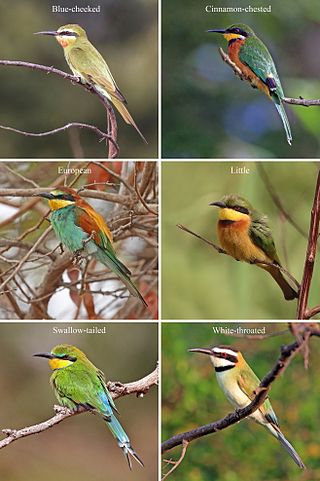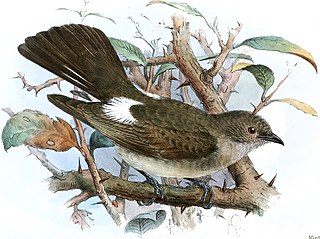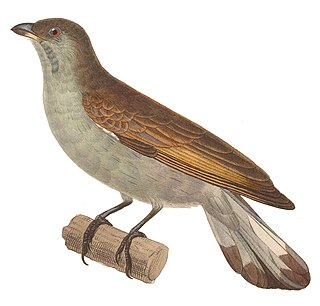
Bees are winged insects closely related to wasps and ants, known for their roles in pollination and, in the case of the best-known bee species, the western honey bee, for producing honey. Bees are a monophyletic lineage within the superfamily Apoidea. They are currently considered a clade, called Anthophila. There are over 20,000 known species of bees in seven recognized biological families. Some species – including honey bees, bumblebees, and stingless bees – live socially in colonies while most species (>90%) – including mason bees, carpenter bees, leafcutter bees, and sweat bees – are solitary.

A honey bee is a eusocial flying insect within the genus Apis of the bee clade, all native to mainland Afro-Eurasia. After bees spread naturally throughout Africa and Eurasia, humans became responsible for the current cosmopolitan distribution of honey bees, introducing multiple subspecies into South America, North America, and Australia.

The bee-eaters are a group of birds in the family Meropidae, containing three genera and thirty species. Most species are found in Africa and Asia, with a few in southern Europe, Australia, and New Guinea. They are characterised by richly coloured plumage, slender bodies, and usually elongated central tail feathers. All have long down-turned bills and medium to long wings, which may be pointed or round. Male and female plumages are usually similar.

New World barbets are near passerine birds from the family Capitonidae of the order Piciformes, which inhabit humid forests in Central and South America. They are closely related to the toucans.

The greater honeyguide is a bird in the family Indicatoridae, paleotropical near passerine birds related to the woodpeckers. Its English and scientific names refer to its habit of guiding people to bee colonies. Claims that it also guides non-human animals are disputed.

Brood parasitism is a subclass of parasitism and phenomenon and behavioural pattern of certain animals, brood parasites, that rely on others to raise their young. The strategy appears among birds, insects and fish. The brood parasite manipulates a host, either of the same or of another species, to raise its young as if it were its own, usually using egg mimicry, with eggs that resemble the host's.

Waxworms are the caterpillar larvae of wax moths, which belong to the family Pyralidae. Two closely related species are commercially bred – the lesser wax moth and the greater wax moth. They belong to the tribe Galleriini in the snout moth subfamily Galleriinae. Another species whose larvae share that name is the Indian mealmoth, though this species is not available commercially.

The yellow-rumped honeyguide is a sparrow-sized bird in the honeyguide family that is found in Asia, mainly in montane forests along the Himalayas. They are very finch-like but the feet are strong and zygodactyl, with two toes facing forward and two backward. They perch on honeycombs and feed on wax. Males tend to be territorial and stay near honeycombs while females and juveniles forage widely. They are brood parasites, laying their eggs in the nests of tree-hole breeders, possibly barbets.

Honeybirds are birds in the genus Prodotiscus of the honeyguide family. They are confined to sub-Saharan Africa.

Apis laboriosa or Himalayan giant honey bee, is the world's largest honey bee; single adults can measure up to 3.0 cm (1.2 in) in length. Before 1980, Apis laboriosa was considered to be a subspecies of the widespread Apis dorsata, the giant honey bee, but in 1980 and for almost 20 years thereafter it was elevated to the rank of a separate species. It was classified once again as a subspecies of Apis dorsata by Michael S. Engel in 1999, but was confirmed as a full species in 2020 on the basis of co-occurrence with Apis dorsata at many sites with no sign of interbreeding. It is highly adapted to its highland habitat in behavior.

The Hadza, or Hadzabe, are a protected hunter-gatherer Tanzanian indigenous ethnic group from Baray ward in southwest Karatu District of the Arusha Region. They live around the Lake Eyasi basin in the central Rift Valley and in the neighboring Serengeti Plateau. As of 2015, there are between 1,200 and 1,300 Hadza people living in Tanzania. However, only around 400 Hadza still survive exclusively based on the traditional means of foraging. Additionally, the increasing impact of tourism and encroaching pastoralists pose serious threats to the continuation of their traditional way of life.

The striped kingfisher is a species of bird in the tree kingfisher subfamily. It was first described by Edward, Lord Stanley, in Salt's Voyage to Abyssinia in 1814 as "Chelicut kingfisher" Alaudo Chelicuti.

The least honeyguide is a small species of bird in the family Indicatoridae. It is found in sub-Saharan Africa.

The scaly-throated honeyguide is a species of bird in the family Indicatoridae. They have a mutualistic relationship with humans in which they attract beekeepers towards bees' nests and then feeding on the remains, especially larvae.

The double-toothed barbet is a species of bird in the family Lybiidae. It is found in Angola, Benin, Burundi, Cameroon, Central African Republic, Republic of the Congo, Democratic Republic of the Congo, Ivory Coast, Equatorial Guinea, Ethiopia, Gabon, Ghana, Guinea, Guinea-Bissau, Kenya, Liberia, Mali, Nigeria, Rwanda, Sierra Leone, South Sudan, Tanzania, Togo, and Uganda. Within Lybius bidentatus, there are two subspecies: Lybius bidentatus bidentatus and Lybius bidentatus aequatorialis.
The yellow-footed honeyguide is a species of bird in the family Indicatoridae. It is found in Cameroon, Guinea, Liberia, Sierra Leone, Ivory Coast, Ghana and Nigeria. Its natural habitat is subtropical or tropical moist lowland forests. It is threatened by loss of its forest habitat.

Indicator is a genus of near passerine birds in the honeyguide family. The name refers to the behaviour of some species, notably the greater honeyguide, which guide humans to bee colonies so that they can share in the spoils of wax and insects when the nest is broken into.
In linguistics, displacement is the capability of language to communicate about things that are not immediately present ; i.e., things that are either not here or are not here now.

Mellivory is a term for the eating of honey. Honey is a sweet and viscous substance created by some eusocial insects, notably bees, for consumption by members of their hives, especially their young. Honey is also consumed by many other animals including human beings, who have developed beekeeping to make supplies of honey both reliable and plentiful. Despite honey's limited antimicrobial properties, it remains a food source for a variety of microorganisms.


















